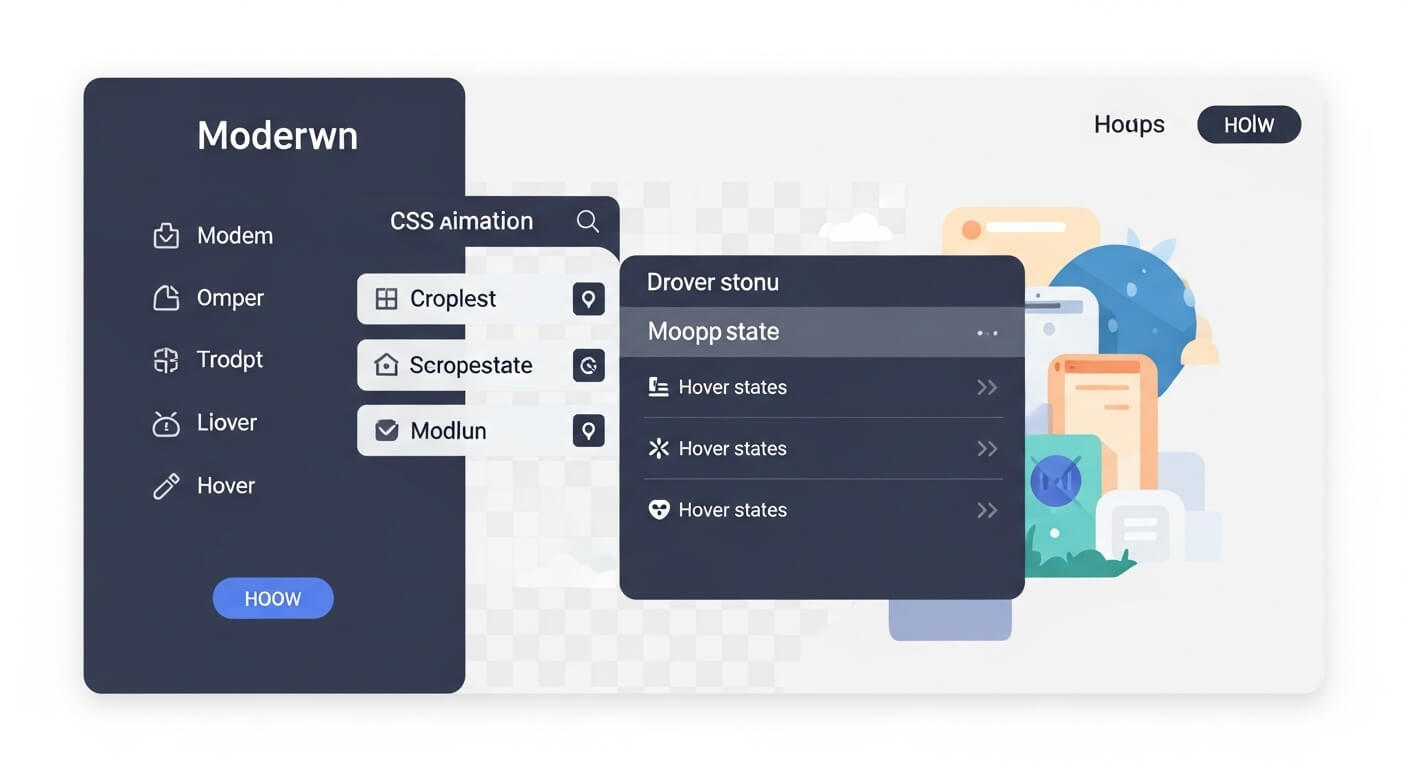When building modern websites, dropdown menu CSS animation plays a crucial role in creating engaging, smooth navigation experiences. Whether you’re designing a mobile-friendly navbar or a desktop mega menu, the right animation can enhance your user interface dramatically.
In this guide, we’ll walk you through 7 stunning dropdown menu CSS animation techniques, complete with live examples, CSS snippets, and best practices.
Read also: How to Overlay Dropdown Menu in CSS: 7 Powerful Tips
What Is Dropdown Menu CSS Animation?
Dropdown menu CSS animation refers to using CSS transitions or keyframes to create smooth and visually appealing effects when a dropdown menu opens or closes. Rather than appearing abruptly, menus slide, fade, or expand gracefully — improving the user’s overall experience.
Popular effects include:
- Slide down/up
- Fade in/out
- Scale transforms
- Accordion-style reveals
Why Dropdown Menu CSS Animation Is Important
Dropdown animations are more than eye candy — they provide:
- Visual feedback to users.
- Improved flow and hierarchy.
- Better user engagement and interaction.
Research by Smashing Magazine shows that smooth transitions can reduce perceived load times and increase retention rates.
Top 7 Dropdown Menu CSS Animation Examples
Let’s dive into the best dropdown menu CSS animation examples you can implement today.
Fade-In Dropdown Animation
.dropdown-menu {
opacity: 0;
transition: opacity 0.3s ease-in-out;
}
.dropdown:hover .dropdown-menu {
opacity: 1;
}Use this for minimalist designs and subtle UI cues.
Slide Down Effect
.dropdown-menu {
max-height: 0;
overflow: hidden;
transition: max-height 0.4s ease;
}
.dropdown:hover .dropdown-menu {
max-height: 500px;
}Perfect for vertical menus with multiple links.
Scale Transform Animation
.dropdown-menu {
transform: scaleY(0);
transform-origin: top;
transition: transform 0.3s ease;
}
.dropdown:hover .dropdown-menu {
transform: scaleY(1);
}Adds a slick expanding motion — great for modern UIs.
Accordion Reveal
.dropdown-menu {
height: 0;
padding: 0;
overflow: hidden;
transition: height 0.5s ease;
}
.dropdown:hover .dropdown-menu {
height: auto;
padding: 10px;
}Useful for mobile-friendly collapsible menus.
Slide In from Left
.dropdown-menu {
transform: translateX(-100%);
opacity: 0;
transition: all 0.4s ease-in-out;
}
.dropdown:hover .dropdown-menu {
transform: translateX(0);
opacity: 1;
}Great for sidebar or off-canvas nav items.
Bounce Animation with Keyframes
@keyframes bounceIn {
0% { transform: scale(0.9); opacity: 0; }
60% { transform: scale(1.05); opacity: 1; }
100% { transform: scale(1); }
}
.dropdown-menu {
animation: bounceIn 0.4s ease forwards;
}Adds a dynamic entrance — works well for attention-grabbing menus.
Backdrop Blur with Transition
.dropdown-menu {
backdrop-filter: blur(5px);
opacity: 0;
transition: opacity 0.3s ease;
}
.dropdown:hover .dropdown-menu {
opacity: 1;
}Creates a modern, glassmorphism-style effect.
Best Practices for Dropdown Menu CSS Animation
To ensure your dropdown menu CSS animation feels natural and accessible:
- Use
ease-in-outfor smooth transitions. - Keep animation duration under 500ms.
- Always provide fallbacks for older browsers.
- Combine animations with ARIA roles for accessibility.
- Avoid animating
height: auto— usemax-heightinstead.
Common Mistakes to Avoid
Avoid these errors when adding dropdown menu CSS animation:
Too many effects – Simplicity is key. Overdoing it can confuse users.
Poor performance – Avoid heavy animations on mobile.
No fallback – Always test across browsers.
Lack of accessibility – Use keyboard-friendly menus and screen reader support.
External Resources to Learn More
Here are some trusted tutorials and guides to deepen your CSS animation skills:
- CSS Tricks: All About CSS Transitions
- MDN Web Docs on CSS Animations
- W3Schools Dropdown Menus
- A11y Project on Accessible Navigation
Final Thoughts on Dropdown Menu CSS Animation
Implementing beautiful dropdown menu CSS animation is one of the easiest ways to elevate your site’s navigation and user experience. Whether you prefer minimal fade-ins or bold scale transitions, there’s a CSS technique for every design style.
Start small, test on real users, and continue optimizing. Remember: great UX is in the details — and animations are one of those details that really matter.


Leave a Reply